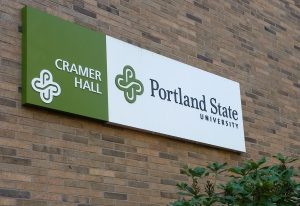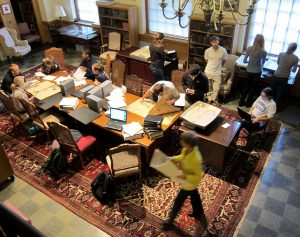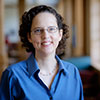This article is more than 5 years old.
A building at Portland State University
As a collections person, I found this conference rather thin on relevant programming, especially since I knew that Roz/Kyle/Kaeley would cover all the instruction angles. That said, the program committee did a good job of spreading the collections-focused sessions among the time slots so I had at least one relevant choice almost every time. I also took advantage of the chance to attend the occasional session outside of my niche, e.g., one on “Complexity and Contradiction in Green Architecture.”
Two presentations were respectively a denunciation and an apologia for DDA. Maybe when the virtual conference comes out I’ll watch them back-to-back and think of them as a debate. I tended to side with the DDA apologist. This fits my natural inclination, but she also used a CC-licensed photo from the ZSR Library Flickr photostream! Her point when showing this picture was that DDA would make libraries’ general collections more alike. Therefore, libraries will distinguish themselves by their special collections.

Miscellaneous Gleanings
On IPEDS statistical craziness: Mount Holyoke has over 600K e-books per ACRL’s definition and only 86 per IPEDS. (For painful detail, see this LibGuide and if you really want to go down the rabbit hole, follow the link to “Questions and Answers from IPEDS.”)
On Collection Development policies: A speaker expressed – with evident dismay – that 44% of ARLs don’t have a collection development policy.
DPLA can virtually reunite physically split collections. They cited a penmanship collection that is physically split between NYPL and the U. of Scranton.
The architecture speaker had learned in school that an optimal design moves water away from the building as quickly as possible. In the emerging green architecture ethos, you want the water to trickle down slowly and get filtered by plants along the way.
Bob Holley on self-published books. He named several categories where the library may want to acquire these works. For instance, local history, fringe perspectives (he cited anti-vaxxers as one example) and personal memoirs that are effectively primary sources.
The rest of this is about e-books
I attended a roundtable discussion on e-books. Nothing too groundbreaking, more like a group therapy session. It’s valuable to know that the challenges we face are also faced by others. NASIG got a name-check as an advocacy group for more library- and user-friendly e-books.
One speaker noted that 6 out of 7 students in a qualitative usability study had a stated preference for print. The speaker said that today’s college students got their early training and developed study habits in a print-centered environment. The preferences of college students may eventually change if K-12 education moves more toward e-books.
Sometimes students use print and e-formats of the same book in tandem. For instance, they may start with the e-book and move over to print for deep reading. Another university found that students used e-books for dip in, dip out reading to support writing papers. (At another conference, the researchers found the dip in, dip out behavior in print books as well.)
Images in e-books are sometimes missing due to permissions issues, so print is a more strongly preferred format for disciplines such as Art History, Theater and Architecture.
Over time, students got more selective about how much they print from e-books. For usability interviews, being guided around e-books made the participants more receptive of the format.
Look at usage of e-book titles that are deleted from the subscription and DDA programs. If there’s anything high use, we may want to buy a copy some other way. I already plan to apply this idea, although I’ll need to keep opportunity costs in mind. (This project may take a lot of time and yield just a few purchases, especially if the deletes are superseded editions.) These presenters found that deleted books had less use, on average, than the overall pool.

5 Comments on ‘Carol’s View of ACRL’
The ebook preferences study sounds interesting! Thanks for sharing!
It’s always good to see our collections be used, and your speaker is absolutely right–it is Special Collections materials which make each library unique.
Good post, Carol!
Carol spoke in a panel discussion on weeding. The best conference title – “Weed it and Reap.” She did an admirable job of explaining our MUVZ approach and how she utilized SCS for the process.
I do wonder if my kids will prefer ebooks as they have fewer and fewer print textbooks each year.